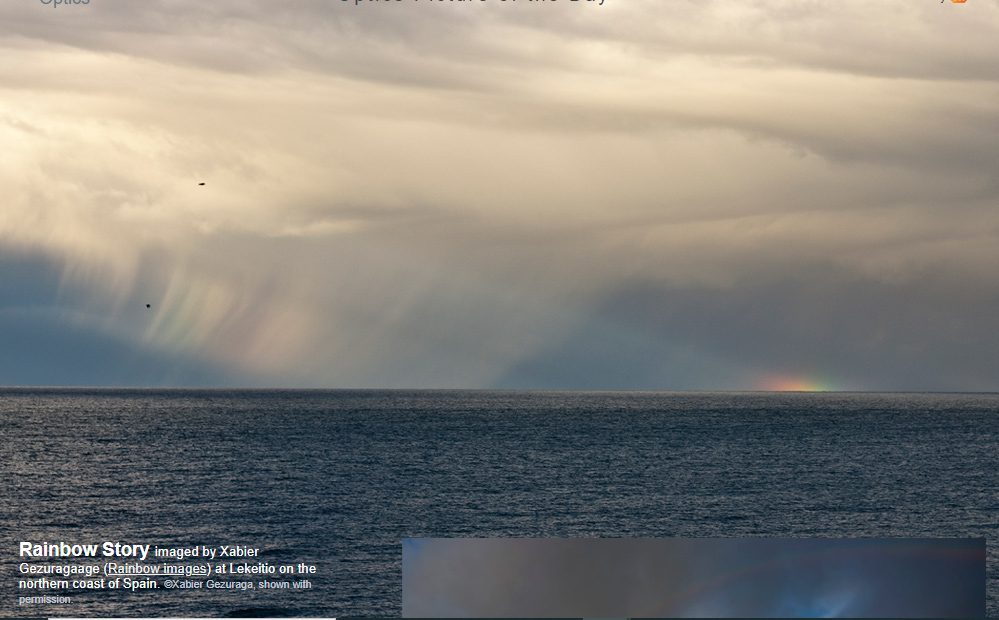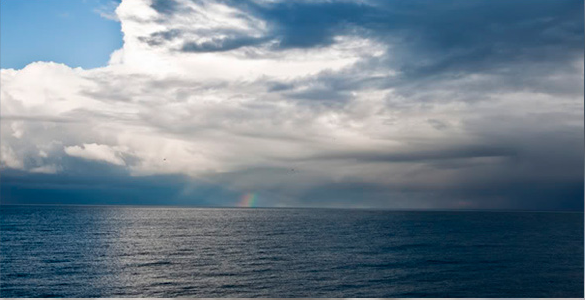Rainbow Story
The Enigmatic Beauty of Rainbows
Rainbows are one of nature's most captivating optical phenomena. They can take on various forms and guises, often leaving us in awe of their beauty. While most of us are familiar with the classic semicircular rainbow arching across the sky after a rain shower, there is much more to these elusive wonders than meets the eye.
A Rainbow Imprisoned
In a remarkable capture by Xabier Gezuragaage, a photographer based in Lekeitio on the northern coast of Spain, we witness a mesmerizing spectacle of a rainbow trapped within an anticrepuscular ray. As a spear of sunlight penetrates the clouds, it creates a spoke-like formation that houses the rainbow within. This rare occurrence highlights the intricate interplay between light, clouds, and atmospheric conditions that give rise to these extraordinary displays.
The Dance of Primary and Secondary Bows
In another stunning image, we observe the primary bow hugging the horizon while leftwards virga streaks are illuminated by the reversed colors of the secondary bow. This captivating dance of colors showcases the symphony of light refraction and reflection that occurs within raindrops suspended in the air. The primary bow is formed by a single internal reflection within raindrops, while the secondary bow is created by two internal reflections.
Complete Rainbow Arcs and Antisolar Shadows
Moving on to the next picture, we witness a scene where rain is nearby, but behind Xabier, the clouds have parted to reveal complete rainbow arcs. In this instance, Xabier's shadow marks the antisolar direction, which is opposite to the position of the Sun. This unique perspective allows us to appreciate the full splendor of rainbows as they grace the sky in their ethereal glory.
The Incorporeal Nature of Rainbows
One intriguing aspect of rainbows is their incorporeal nature. While rainbows appear to be tangible and solid, they possess neither distance nor linear dimension. They are intangible manifestations of light interacting with water droplets in the atmosphere. As sunlight passes through these tiny water droplets, it undergoes refraction, dispersion, and reflection, resulting in the formation of rainbows that seem to materialize out of thin air.
Exploring the Science Behind Rainbows
To truly appreciate the enigmatic beauty of rainbows, it is essential to understand the underlying science behind their formation. Rainbows are a result of the interaction between sunlight, water droplets, and the observer's line of sight. Here are some key points to consider:
- Sunlight enters a water droplet and undergoes refraction, bending the light rays.
- The refracted light rays then reflect off the inside surface of the droplet, separating into its component colors through dispersion.
- The separated colors then exit the droplet and undergo further refraction as they leave, creating the curved shape of the rainbow.
- The observer sees the rainbow when their line of sight intersects with the refracted and reflected light rays from the droplets.
The Mystical Symbolism of Rainbows
Rainbows have captivated human imagination for centuries, often carrying symbolic meanings across different cultures. Here are a few interpretations associated with rainbows:
- A symbol of hope and promise: Rainbows are often seen as a sign of good fortune and new beginnings.
- Bridging the gap between heaven and earth: In many mythologies, rainbows are believed to be a bridge connecting the mortal realm with celestial realms.
- Diversity and unity: The vibrant colors of a rainbow coming together in harmony represent the beauty of diversity and the power of unity.
Chasing Rainbows
Rainbows are transient and elusive, making them a subject of fascination for photographers and nature enthusiasts alike. To capture these ephemeral wonders, one must be at the right place, at the right time, with favorable weather conditions. The thrill of chasing rainbows adds an element of excitement and unpredictability to the pursuit, as each rainbow is a unique masterpiece painted by nature.
A Reminder of Nature's Wonders
Rainbows serve as a gentle reminder of the extraordinary beauty and complexity that exists in the natural world. They invite us to pause, appreciate, and marvel at the wonders that surround us. Whether it's a fleeting glimpse of a rainbow after a summer shower or a breathtaking display like the ones captured by Xabier Gezuragaage, these optical marvels continue to inspire and awe us, reminding us of the magic that exists within our atmosphere.
Conclusion
Rainbows are not merely arcs of color in the sky; they are intricate manifestations of light, water, and atmospheric conditions. Their elusive nature and captivating beauty have fascinated humans for centuries. From their imprisonment within anticrepuscular rays to the dance of primary and secondary bows, rainbows never cease to amaze us. As we explore the science behind their formation and appreciate their symbolic meanings, let us remember to cherish these fleeting moments of natural wonder that remind us of the boundless beauty of our world.

Rainbow Story imaged by Xabier Gezuragaage (Rainbow images) at Lekeitio on the northern coast of Spain. ©Xabier Gezuraga, shown with permission.



Rainbows take strange guises. Here they are imprisoned within an anticrepuscular ray/rainbow spoke formed as a spear of sunlight punctures cloud.
A flare of primary hugs the horizon while leftwards virga streaks are lit by the reversed colour secondary bow.
The next picture has rain nearby. But behind Xabier the clouds have parted to allow complete rainbow arcs. Xabier's shadow marks the antisolar direction.
The close rain forms the bows backed by more distant sea. Only the rain with its spectral glints is nearby. Rainbows themselves have neither distance nor linear dimension – they are incorporeal.
Note: this article has been automatically converted from the old site and may not appear as intended. You can find the original article here.
Reference Atmospheric Optics
If you use any of the definitions, information, or data presented on Atmospheric Optics, please copy the link or reference below to properly credit us as the reference source. Thank you!
-
<a href="https://atoptics.co.uk/blog/rainbow-story/">Rainbow Story</a>
-
"Rainbow Story". Atmospheric Optics. Accessed on November 26, 2024. https://atoptics.co.uk/blog/rainbow-story/.
-
"Rainbow Story". Atmospheric Optics, https://atoptics.co.uk/blog/rainbow-story/. Accessed 26 November, 2024
-
Rainbow Story. Atmospheric Optics. Retrieved from https://atoptics.co.uk/blog/rainbow-story/.